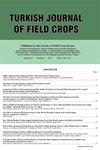二茬大豆[Glycine max (L.) Merrill]的路径系数和相关性分析
IF 0.8
4区 农林科学
Q3 AGRONOMY
引用次数: 0
摘要
大豆[甘氨酸max (L.)]稳定。在2014年、2015年和2016年作为第二季作物进行了基因型研究,以确定产量和产量构成。采用4个重复的随机完全区组设计布置大田试验,采用相关分析和通径分析确定大豆基因型各性状对籽粒产量的直接和间接影响。对各性状进行方差分析,得出基因型x年交互作用在1%概率水平上具有统计学显著性的结论。表现最好的基因型对籽粒产量KASM 03(3660.9公斤农业,为每植物与94.8 KASM 03豆荚,豆荚的株高BATEM 306和ATAEM 7(87.2厘米和87.9厘米),第一仓高度BATEM 317(12.8厘米),100 -种子重量BDUS 04 (21.1 g),天% 50开花是ARISOY(33.2天)天到期的布拉沃(102.1天),对原油比ARISOY 21(%)和粗蛋白比例是BATEM 223 46.6(%)。相关分析结果显示,6个性状与籽粒产量呈正相关,其余性状与籽粒产量呈负相关。6个性状分别为单株荚果数(r= 313.3*)、开花至50%的天数(r= 0.270*)、成熟至成熟的天数(r=0.286*)。,株高(r=0.027ns),首荚高(r=0.181ns)。粗蛋白质比(r=0.112ns)。通径系数分析表明,单株荚果数(0.5532)对籽粒产量有显著的直接影响,其次是日数至成熟期(0.2483)、株高(0.1920)、粗蛋白比(0.0403)、首荚高(0.0266)和开花天数至50% (0.0104);百粒重(-0,1697)和原油比(-0,0097)对籽粒产量有直接负向影响。结果表明,单株荚果数对籽粒产量有较高的直接正向影响,可作为籽粒产量的选择标准。本文章由计算机程序翻译,如有差异,请以英文原文为准。
PATH COEFFICIENT AND CORRELATION ANALYSIS IN SECOND CROP SOYBEAN [Glycine max (L.) Merrill]
Fourteen soybean [Glycine max (L.) Merr.] genotypes were studied as second crop in 2014,
2015 and 2016 to determine the yield and yield components. Randomized complete block
design with four replicates was used for laying out the field experiments at research fields of
Ege University Correlation and path coefficient analysis were used to determine the direct and
indirect effects of variuos traits of grain yield in soybean genotypes. Variance analysis was
perform for each characters and it was concluded that the genotype x year interaction was
statistically significant at the 1% probability level in terms of all the traits examined. The best
performing genotype for grain yield was KASM 03 (3660.9 kg ha-1), for pod per plant was
KASM 03 with 94.8 pods, for plant height were BATEM 306 and ATAEM 7 (87.2 cm and
87.9 cm), for first pod height was BATEM 317 (12.8 cm), for 100-seed weight was BDUS 04
(21.1 g), for days to %50 flowering was ARISOY (33.2 days), for days to maturity was
BRAVO (102.1 days), for crude oil ratio was ARISOY (%21) and for crude protein ratio was
BATEM 223 (%46.6). According to results of the correlation analysis, it is seen that six traits
are positively correlated with grain yield, while the other traits are negatively correlated with
seed yield. The six characters are pod numbers per plant (r= 313.3*), days to 50% flowering
(r= 0.270*), days to maturity (r=0.286*)., plant height (r=0.027ns), first pod height
(r=0.181ns). and crude protein ratio (r=0.112ns). Path coefficient analysis showed grain yield
positively and directly affected by pods number per plant (0,5532) followed by day to
maturity (0,2483), plant height (0,1920), crude protein ratio (0,0403), first pod height (0,0266)
and days to 50% flowering (0,0104); Grain yield was negatively and directly affected by 100-
seed weight (-0,1697) and crude oil ratio (-0,0097). In conclusion pod number per plant could
be used as a selection criterion due to its high direct and positively affect on grain yield.
求助全文
通过发布文献求助,成功后即可免费获取论文全文。
去求助
来源期刊

Turkish Journal of Field Crops
AGRONOMY-
CiteScore
1.50
自引率
12.50%
发文量
21
审稿时长
>12 weeks
期刊介绍:
Information not localized
 求助内容:
求助内容: 应助结果提醒方式:
应助结果提醒方式:


